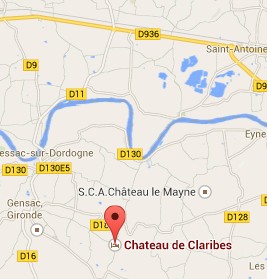-
What is vegetarian wine?
“Isn’t all wine vegetarian, it’s made from grapes?”
Wine is essentially made from grapes, however animal products are commonly used in the production process, and these wines may not be a suitable part of a vegetarian or vegan diet.
Animal-derived products are used to clear and brighten wine, removing proteins, yeast, and other particles which are in suspension during the fermentation. Examples of animal products used as clearing agents are gelatin (bone), isinglass (fish bladders), chitosan (shellfish shell), casein (milk protein) and egg albumen (egg white). Bull’s blood is used in some countries but is not allowed in the U.S. or Europe. Casein and albumen are normally acceptable for vegetarians, but not for vegans and not for people with milk or egg allergies.
“At Château de Claribès we use natural methods and only produce vegetarian* and vegan wine.”
To remove sediment: Natural settling in time & cool temperatures and the lunar cycle to determine when to undertake racking.
To remove proteins: from white and rosé wines we use Bentonite, a volcanic clay mineral.
To remove proteins: from red wines we use a natural vegetable clearing agent if necessary.
“We state clearly on our labels and the online-shop which wines are suitable for vegetarians and vegans.”
Current regulations do not require wine labels to declare the clearing agents used or declare whether the wine may contain allergens. There are moves in Europe to change this but they are not yet in effect.
“Organic or Biologique” wine is not necessarily vegetarian or vegan. There are Organic approved versions of all the animal clearing and brightening agents!
*For our first vintage 2005 we used albumen to clear the reds, hence they are suitable for vegetarians. All our other wines and vintages are suitable for vegans and vegetarians.
-
Do you bottle the wine ?
We do, all the wine we make and sell is bottled at the Château.
You can check this on any French wine as it must be stated on the label. The words “mis en bouteille au Château” will be on the label if the wine is made and bottled at the estate. You cannot use these words for any other case
The label generally can be an indication as to the quality level of the wine, and whether it was bottled by a single producer, or more anonymously and in larger quantities.
General Guide
“Mis en bouteille …”
“… au château, au domaine, à la propriété”: these have a similar meaning, and indicate the wine was “estate bottled”, on the same property on which it was grown or at a cooperative (within the boundary of the appellation) of which that property is a member.
“… par …” the wine was bottled by the concern whose name follows. This may be the producing vineyard or it may not.
“… dans la région de production”: the wine was not bottled at the vineyard but by a larger business at its warehouse; this warehouse was within the same winemaking region of France as the appellation, but not necessarily within the boundary of the appellation itself. If a chateau or domaine is named, it may well not exist as a real vineyard, and the wine may be an assemblage from the grapes or the wines of several producers.
“… dans nos chais, dans nos caves”: the wine was bottled by the business named on the label.
-
How do I store wine ?
It is important to consider how you will store wine. Wine is a natural, perishable food product. Left exposed to heat, light, vibration or fluctuations in temperature and humidity, all types of wine can spoil. When properly stored, wines not only maintain their quality but many actually improve in aroma, flavor, and complexity as they mature. Store wine well and you will be amply rewarded.
Wine will store well at temperatures between 7–18 °C provided any temperature variation is gradual. For long term aging a constant temperature of 13 °C works best. Rapid changes in temperature can result in air passing the cork as the liquid expands and contracts, this can cause the wine to age prematurely.
There are many theories about humidity and wine storage, in general it’s thought that a humid rather than a very dry atmosphere is preferable as this prevents the organic material of the cork from contracting, which may lead to leaks and premature aging.
Three tips to Store Wine
Temperature:
Ideally, this should be stable at about 54-57°F (12-14°C), all year round. If the temperature is too high, the wine will age much more rapidly.
Humidity:
The ambient humidity should be constant throughout the year, at about 70-80%. Drier conditions may dry out the corks and higher humidity may damage both corks and labels.
Light:
This should be as subdued as possible, and neon lights are best avoided.
-
What is the best way to transport wine?
Lots of people ask us “what is the best way to transport wine?”
This is often asked by people buying wine from the Château door for transport home by car or flying across Europe and as far as Australia. We give some general guidance and we have designed our own packaging to help.
Transport wine – 3 general rules to remember
no. 1
Always carry your bottles upright so they do not leak.
We actually pack the wine in cases flat to prevent the cork from drying. The majority of our wine is closed with a particularly tight fitting cork to prevent leaks (bad if a bottle leaks in the middle of a stacked pallet !!). So far we have had zero leaks “touch wood”.
no. 2
Avoid transporting wine during extremely hot or cold weather.
no. 3
Wine does not like rude shocks, so you will need to let
it rest for two or three weeks before serving.
